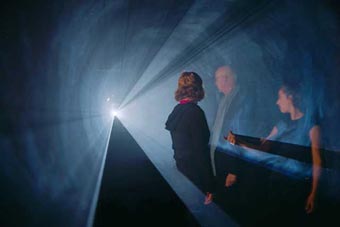Group Critique 3
Other mentionable works where the audience completes the piece are Tall Ships by Gary Hill and Anthony McCall's work with light.
During the critique Charlie Murphy mentioned several interactive artists that could help inform my work. Paul Sermon's Telematic Dreaming is one such installation which explores real and projected audience interactions.
Other mentionable works where the audience completes the piece are Tall Ships by Gary Hill and Anthony McCall's work with light. Helen Maurer's use of projectors with mirrors is relevant because of relationships drawn between the real and virtual.
 High Tide 2006. by Helen Maurer. Overhead projector, glass, mirror and painted wood. [Image Source]
High Tide 2006. by Helen Maurer. Overhead projector, glass, mirror and painted wood. [Image Source]
 Anthony McCall. Line Describing a Cone. (1973, 16mm film) at the Whitney Museum exhibition “Into The Light,” 2001-2. Photograph © Henry Graber, 2002.
Anthony McCall. Line Describing a Cone. (1973, 16mm film) at the Whitney Museum exhibition “Into The Light,” 2001-2. Photograph © Henry Graber, 2002.
Charlie also mentioned the essay In Praise of Shadows by Jun'ichirō Tanizaki, which is a beautiful discussion of aesthetics and the conflict between west and east. Since my final work uses different types of shadows in the installation, Tanizaki's writing helped me look at metaphorical layers behind the shadow and differences in cultural meanings and perception. During the presentation some interesting quotes from Eyes of the Skin by Julian Pallasmaa caught my attention and when I had the book in my hands I discovered the chapter The Significance of the Shadow, which added to my increasing knowledge of how different theorists contextualize the shadow and its perceived meanings.
Reference Tanizaki, J. 1977. In Praise of Shadows. Leete's Island Books: USA Pallasmaa, J. 1996. Eyes of the Skin: Architecture and the Senses. John Wiley and Sons: USA
Reflection
The first turning point was a discussion with Phil Beards about focussing my topic of interest for the MA. Based on Phil's suggestion, I ended up brainstorming and created a mind map which outlined the proposed area of study.Initially I was uncertain about which bipolarity I should study and looked at several opposing factors within Mumbai such as ugly and beautiful and poverty versus luxury. During the course of my research on Mumbai's architecture, I stumbled on an article by Ashraf K. Kazi (2005) where he mentions the concept of elsewhere and it's relation to the evolving architecture of Mumbai city. This conflict between the elsewhere and the here was the perfect example of bipolarity; juxtaposing the luxurious pseudo-greek high rises of Hiranandani with the crowded squalor of the Tunga slums.
A brainstorming discussion with Liam Birtles helped expand my thoughts on the final installation work. We discussed several ideas and technical possibilities, hidden cities, the use of shadow, and how time could also be a factor within the installation. Eventually the most important event was the installation test in December which helped me see my work in it's intended medium for the first time. Several issues needed much more thought such as the use of space, time and sound and how these could in turn interact with the audience while flowing with the theory and concept. This first experimental installation and the consequent discussions and findings helped clarify my concept and goals for phase 1.
A string of events in the last two and a half weeks of phase 1 helped synthesize my aims and theoretical framework. A peer critique encouraged me to continue using real shadows and a group critique steered me towards the works of Kit Wise and theories of heterotopia. While creating the presentation for the group critique I also analyzed and listed the technical limitations of my current installation experiments. And a final tutorial with Phil helped me start planning for Phase 2 and the use of interactive sound.
Phase 1 was an experimental phase, just like the final work from Phase 1 is an experiment and not a formal installation to be placed in an art gallery. Several factors will be taken into account for Phase 2, based on the findings of the installation experiment conducted on 20th of January. These will probably include research into the history of shadows, use of sound, technical details, coding, the 360 panorama and how these additional layers could affect the audience experience. Most importantly phase 2 will not be an experimental phase, but a project phase which will focus on the dissemination and application of my practice.
Reference
Ashraf, K Kazi. (2005) Masala City: Urban Stories from South Asia. The New Mix: Culturally dynamic architecture, Sara Caples and Everardo Jefferson, Architectural Design. Vol 75, No 5 Sept/Oct 2005, pp.67-68.


